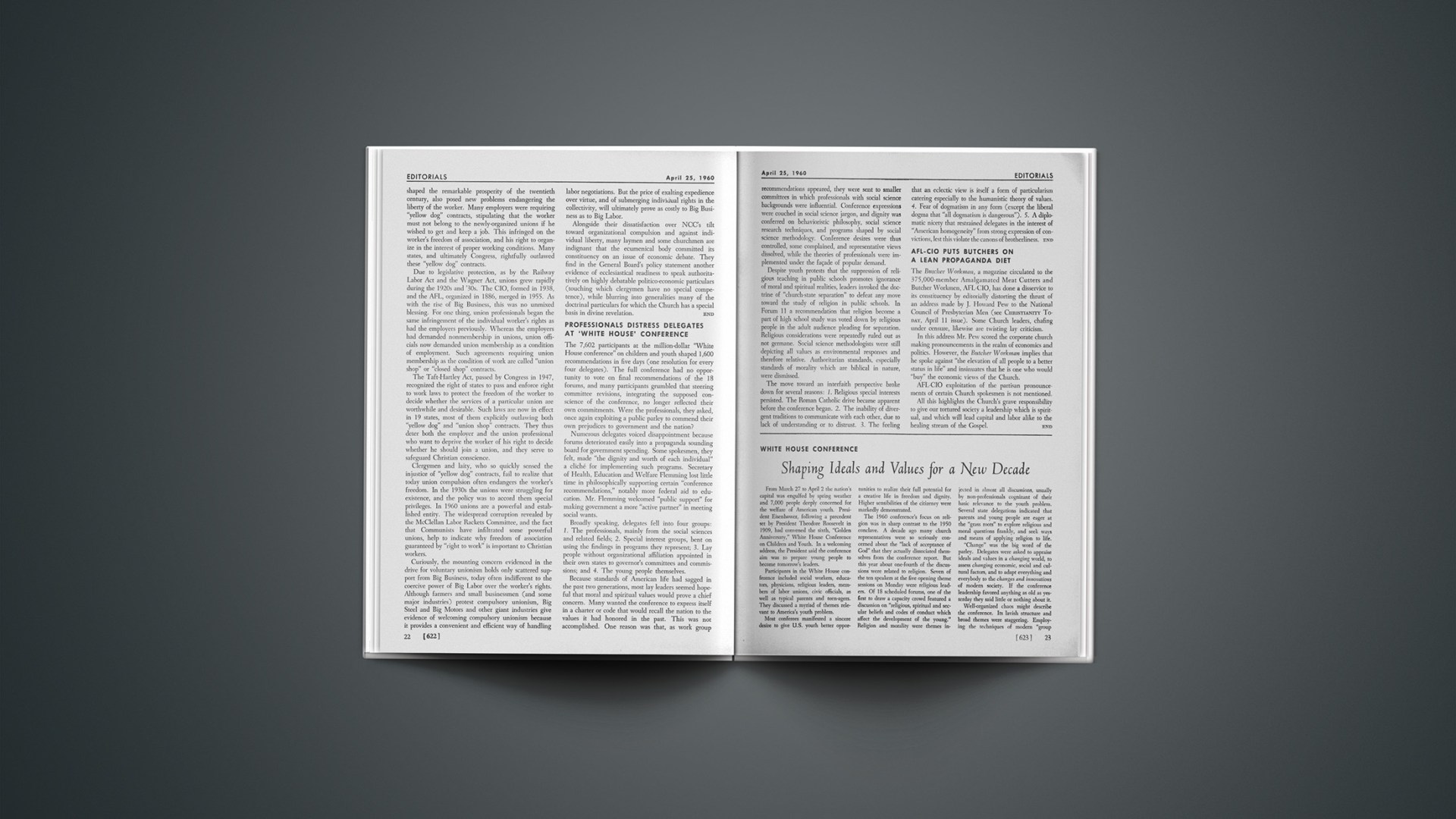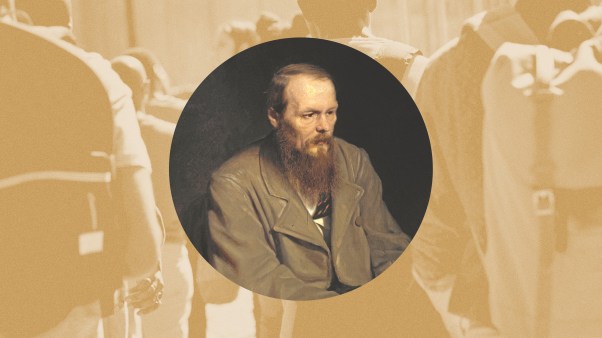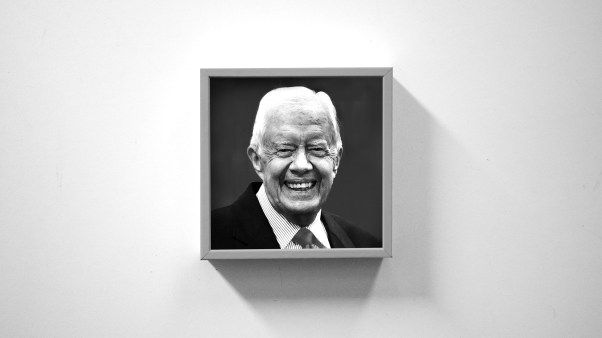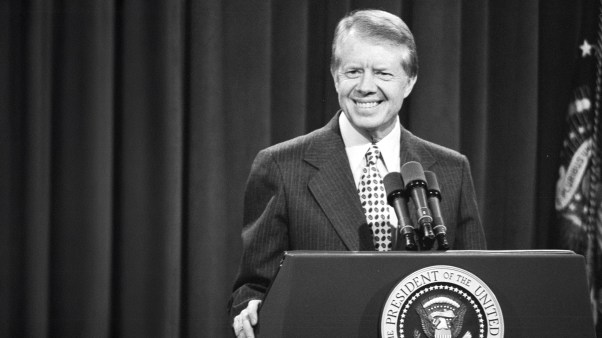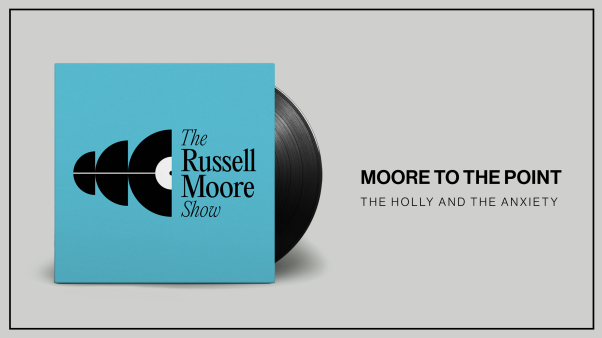From March 27 to April 2 the nation’s capital was engulfed by spring weather and 7,000 people deeply concerned for the welfare of American youth. President Eisenhower, following a precedent set by President Theodore Roosevelt in 1909, had convened the sixth, “Golden Anniversary,” White House Conference on Children and Youth. In a welcoming address, the President said the conference aim was to prepare young people to become tomorrow’s leaders.
Participants in the White House conference included social workers, educators, physicians, religious leaders, members of labor unions, civic officials, as well as typical parents and teen-agers. They discussed a myriad of themes relevant to America’s youth problem.
Most conferees manifested a sincere desire to give U.S. youth better opportunities to realize their full potential for a creative life in freedom and dignity. Higher sensibilities of the citizenry were markedly demonstrated.
The 1960 conference’s focus on religion was in sharp contrast to the 1950 conclave. A decade ago many church representatives were so seriously concerned about the “lack of acceptance of God” that they actually dissociated themselves from the conference report. But this year about one-fourth of the discussions were related to religion. Seven of the ten speakers at the five opening theme sessions on Monday were religious leaders. Of 18 scheduled forums, one of the first to draw a capacity crowd featured a discussion on “religious, spiritual and secular beliefs and codes of conduct which affect the development of the young.” Religion and morality were themes injected in almost all discussions, usually by non-professionals cognizant of their basic relevance to the youth problem. Several state delegations indicated that parents and young people are eager at the “grass roots” to explore religious and moral questions frankly, and seek ways and means of applying religion to life.
“Change” was the big word of the parley. Delegates were asked to appraise ideals and values in a changing world, to assess changing economic, social and cultural factors, and to adapt everything and everybody to the changes and innovations of modern society. If the conference leadership favored anything as old as yesterday they said little or nothing about it.
Well-organized chaos might describe the conference. Its lavish structure and broad themes were staggering. Employing the techniques of modern “group dynamics,” delegates met in five simultaneous forums and 210 simultaneous work groups in 80-odd buildings in the Washington area. Many never saw the White House. When findings of work groups were correlated into a general report, confusion was confounded. Leaders finally announced that findings would be mailed.
One had a feeling that the group-dynamic technique which has so often been employed to disseminate propaganda, was serving that purpose in the White House conference. A Kansas juvenile court judge charged that professional social workers were dominating work groups. A religion education specialist from Illinois noted a preponderance of humanist idealism.
Roman Catholic and Jewish influences were strong. Some of the most convincing observations on abiding religious and moral values came from Catholic leaders. The Very Rev. Msgr. Raymond J. Gallagher coordinated Catholic participation. He prepared a rather controversial handbook for guidance of Catholic delegates advising them to “be appropriately aggressive within your work groups so that a fair number of our people will be elected by their group as their recorder and representative in the forum delegations” (where voting on the findings took place). The handbook also contained the Catholic view of the issues confronting delegates. Jewish delegates received a booklet, “Safeguarding Religious Liberty,” which stated a consensus of Jewish opinion on controversial matters.
Protestant contributions to the religious colloquy were notably weak though Protestantism furnished a majority of the leadership personnel. “A Supplemental Resource,” 30-page booklet compiled by a humanist-minded Methodist clergyman, the Rev. Dean M. Kelley, was made available to Protestants “at the request and with the advice of members of the staff of the National Council of Churches.” The NCC played a large part in conference planning. The Rev. Dr. William J. Villaume, executive director of the NCC Department of Social Welfare, was a member not only of the President’s National Committee for the conference but of the Executive Committee, the important Steering Committee, and the Committee on Program. He also directed the Committee on Organization and Arrangements.
Conservative or evangelical Protestantism was virtually ignored in the choice of conference leadership at all levels. Non-NCC agencies were approached about financing the conference as sponsors and scores of them were acknowledged in the official program, but their leaders and specialists were absent on the platforms and at the heads of workshop tables. Many capable persons solicitous for the success of the White House conference, and faithful in attendance and participation, felt that the views of nearly 30,000,000 American Protestant conservatives were disowned at the leadership level.
A wealth of timely notes were sounded in addresses. A mother representing the United Church Women of Minneapolis, Mrs. Wright W. Brooks, said, “It is curious that the need of discipline is accepted in every other field, save that of morals.… If we as parents believe standards are necessary then discipline is certainly needed to attain them.” Rabbi Julius Mark of New York City stressed that “only the secure family, firmly founded on basic spiritual loyalties can rear children who place their confidence in the power of faith and the values of proper ethical conduct.” Dr. Milton J. E. Senn of Yale’s Child Study Center warned that “the nature of religious revival in America seems to be social rather than spiritual” … “people are becoming church members in an effort to gain status and security rather than salvation.” The Very Rev. Laurence J. McGinley, president of Fordham University, said a new national consciousness of values must derive from persons who have “a vital inner stability” gained “not from contemporary mores but from transcendent values personally understood.” He cited these values as “man’s origin, his destiny, God’s providence, His love and His sanctification of this world by His presence in it!” Such views were not representative of the conference as a whole, however.
Loud applause greeted an address by Dr. T. V. Smith, noted humanist philosopher. Dr. Smith asserted that the idea of God is good, but that since there are many ideas of God, little consensus can be reached on the subject. He recognized the values of the current “Judeo-Christian-Greek-Humanist” code of morality in America, but declared that because we are moving into a universal society, we must be prepared to accept values of other cultures and religions which may well be better for the new space age. He also stated that, under certain circumstances, immorality rather than morality might serve good ends. In beautiful, poetically-phrased diction basic Christian beliefs were denied.
For the most part, workshops were disappointing. One concerned with religious values spent the entire allotted time seeking to define “faith.” Said a New Mexico girl, “We young people came here hoping to get some solutions for our problems, but it seems our leaders cannot agree among themselves on principles to say nothing of courses of action. Can’t we get down to something practical?”
Toward the week end forums began to recommend such things as:
—A nation-wide program to stop school drop-outs.
—Representation of childhood and youth experts on the Federal Communications Commission, allocation of additional high-frequency channels for educational television.
—More federal aid to public schools, higher teacher salaries.
—Federal and state action to integrate public schools.
—More liberal public assistance grants, including counselling services.
—Better housing, education and working standards for migrant laborers.
—Stronger community programs, creative work for youth.
—That the home and family be made a central force in democracy.
—Greater youth participation in public affairs through voluntary organizations and political activity.
—Active support of the United Nations and participation in positive material policies for the attainment of peace with justice.
—Religion essential for the strengthening of standards and value systems.
Some 1,600 recommendations came up from the forum level. Many delegates claimed that proposals were “railroaded through.” Others claimed that drafting committees often ignored actions of the forum in their reports. In general, delegates agreed that real efforts had been made by forum leaders, under difficult circumstances, to observe fair practices. Yet there was wide feeling that when the final report of the conference is drafted it will probably reflect the views of its framers more than the general consensus of the conferees.
A strong move is afoot to reconstruct the conference into a permanent government bureau.
Opponents of the idea see it as a move toward a top-heavy bureaucracy and central government interference with concerns which are primarily state and community matters.
“One-worlders” are especially anxious that the committee initiate a world conference on children and youth to translate the “essence of democracy” to other countries.

